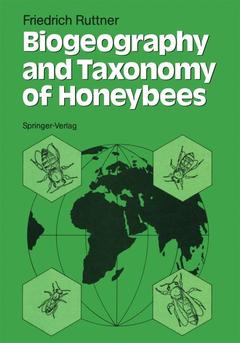Biogeography and Taxonomy of Honeybees, 1988
Langue : Anglais
Auteur : Ruttner Friedrich

Honeybees are as small as flies or as large as hornets, nesting in nar row cavities of trees and rocks or in the open on large limbs of trees 30 m above ground. They occur in tropical zones and in the forests of the Ural mountains, they survive seven months of winter and even longer periods of drought and heat. Historically, they lived through a extended time of stagnation in the tropics from the mid-Tertiary, but then experienced an explosive evolution during the Pleistocene, re sulting in the conquest of huge new territories and the origin of two dozen subspecies in Apis mellifera. This vast geographic and ecologic diversification of the genus Apis was accompanied by a rich morphological variation, less on the level of species than at the lowest rank, the subspecies level. Variation being exclusively of a quantitative kind at this first step of speciation, tradi tional descriptive methods of systematics proved to be unsatisfactory, and honeybee taxonomy finally ended up in a confusing multitude of inadequately described units. Effective methods of morphometric-sta tistical analysis of honeybee popUlations, centered on limited areas, have been developed during the last decades. Only the numerical characterization of the populations, together with the description of behavior, shows the true geographic variability and will end current generalizations and convenient stereotypes.
I Honeybees of the World.- 1 The Genus Apis.- 2 Stingless Bees (Meliponinae).- 3 Evolution.- 4 Geographic Variability.- 5 Methods of Honeybee Taxonomy: Past and Present.- 6 Morphometric Analysis and Classification.- 7 Apis florea Fabricius 1787: 305.- 8 Apis dorsata Fabricius 1793: 328.- 9 Apis cerana Fabricius 1793: 327.- II The Western Honeybee Apis mellifera L. Classification and Natural History.- 10 Apis mellifera Linnaeus 1758: 576 General Introduction to a Polymorphic Species with an Unusual Range of Adaptation.- 11 The Races of the Near East (Irano-Ponto-Mediterranean Area).- 12 Honeybees of Tropical Africa.- 13 Honeybees of the Western Mediterranean.- 14 Honeybees of the Central Mediterranean and Southeastern Europe.- References.
Date de parution : 11-2012
Ouvrage de 284 p.
17x24.4 cm
Thèmes de Biogeography and Taxonomy of Honeybees :
Mots-clés :
adaptation; biogeography; classification; development; distribution; ecology; ecosystem; evolution; taxonomy
© 2024 LAVOISIER S.A.S.



